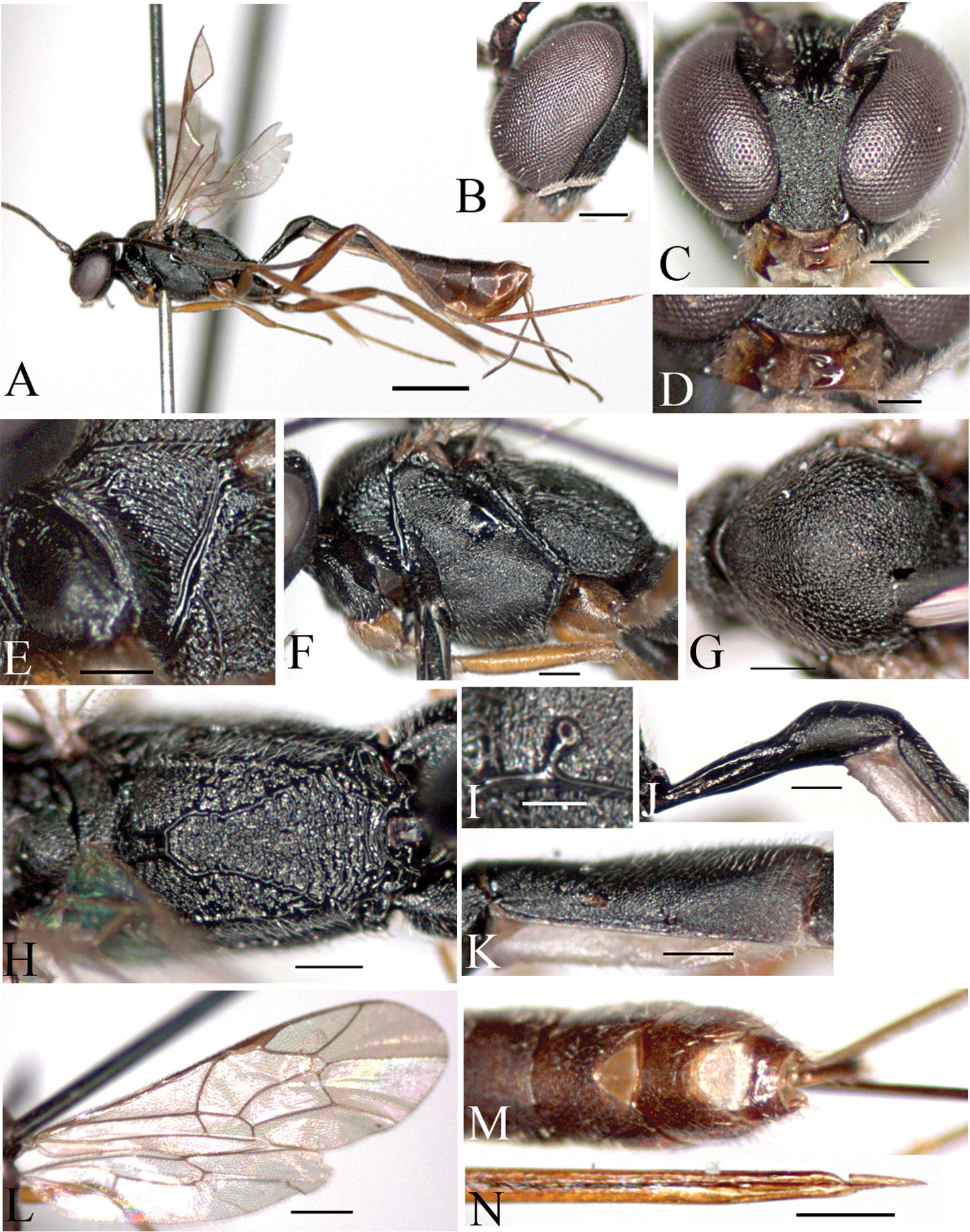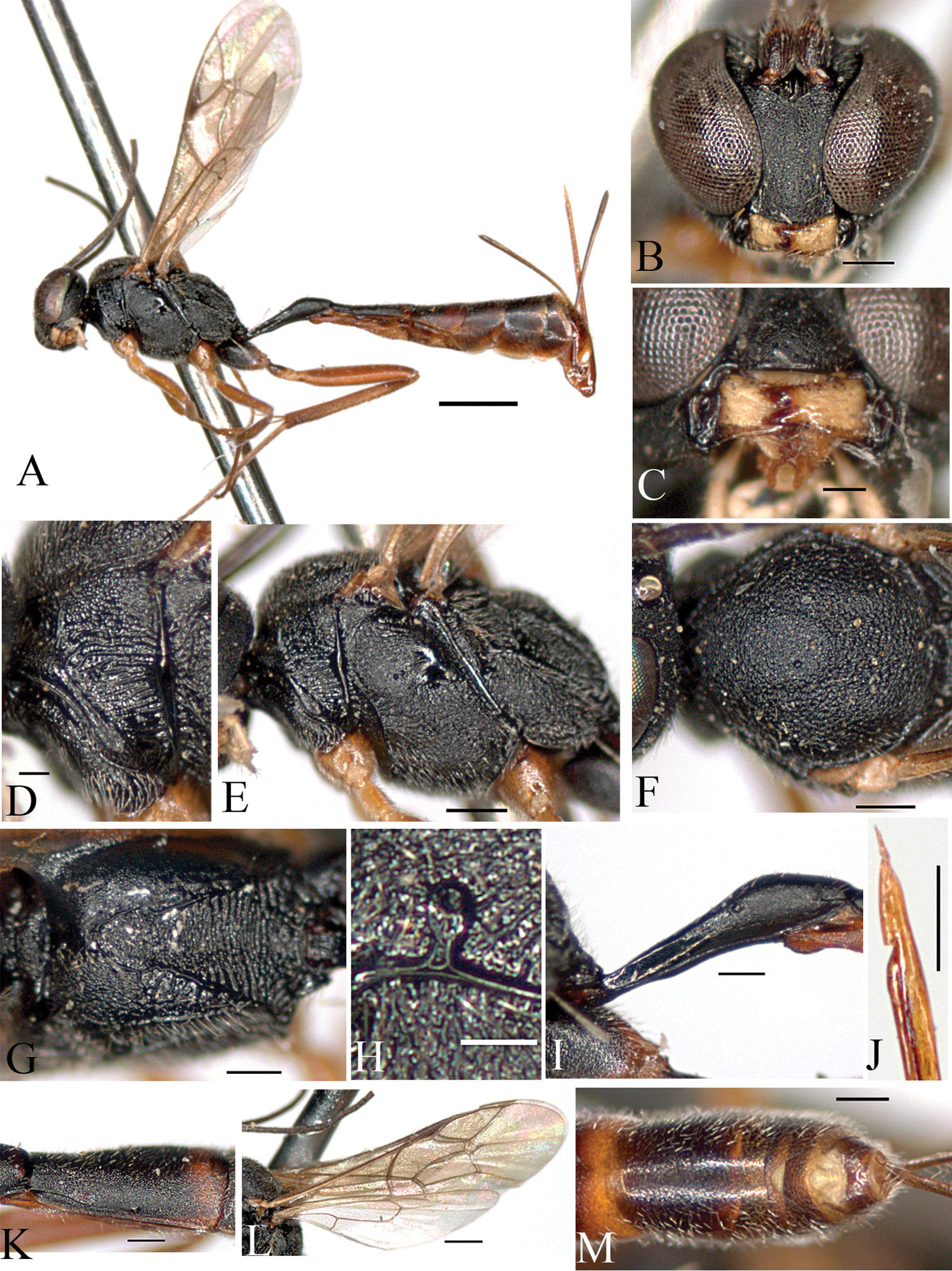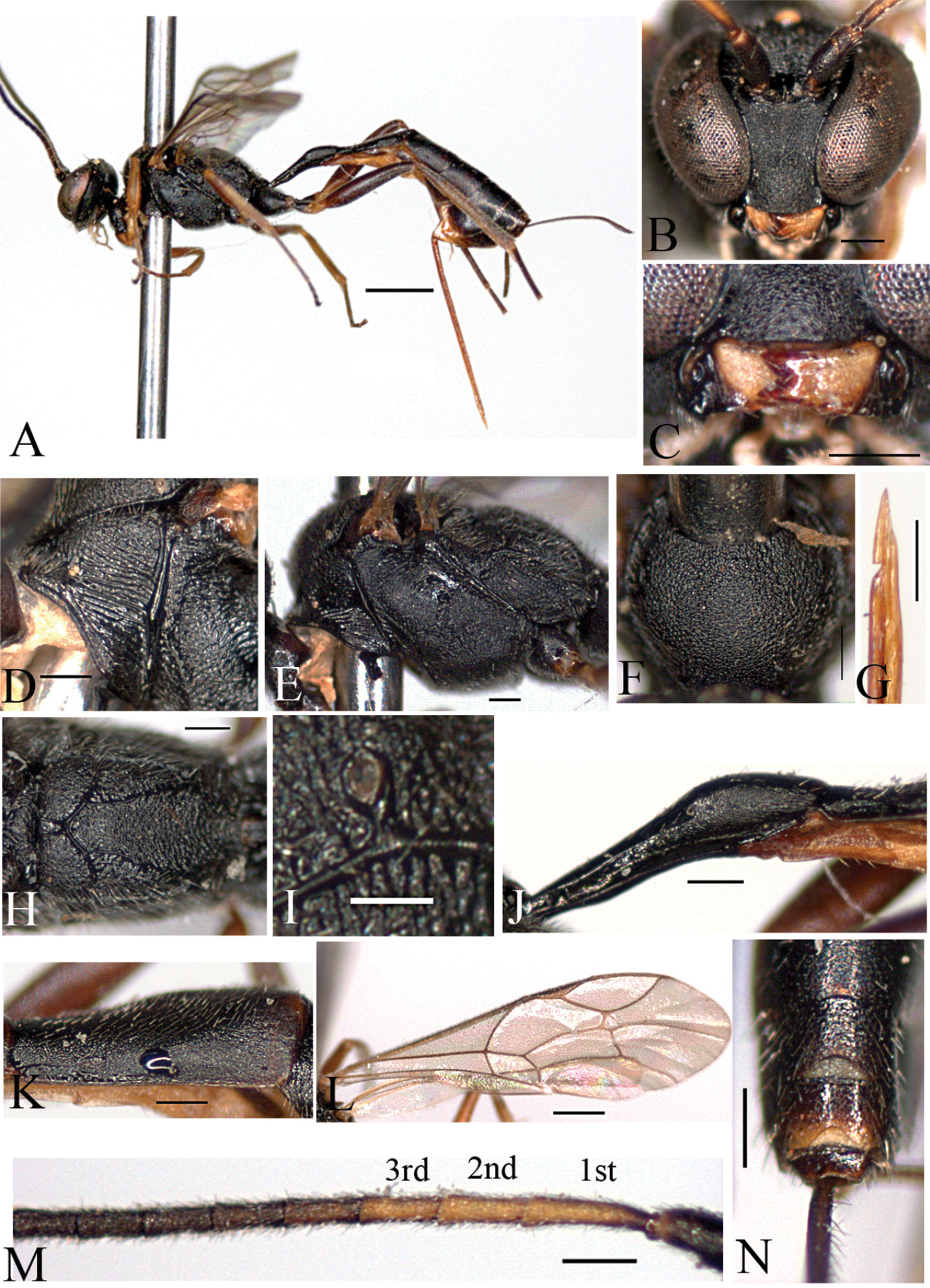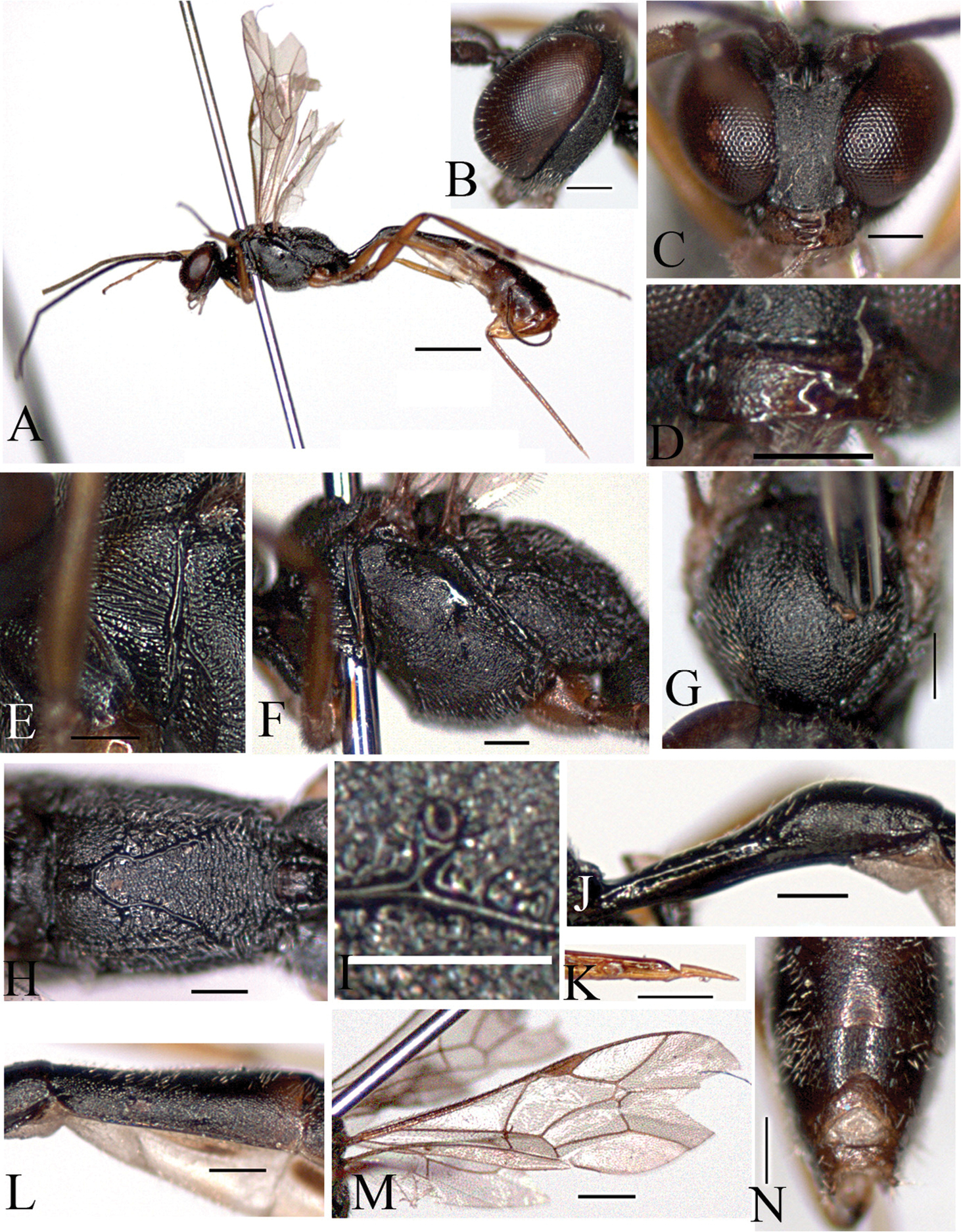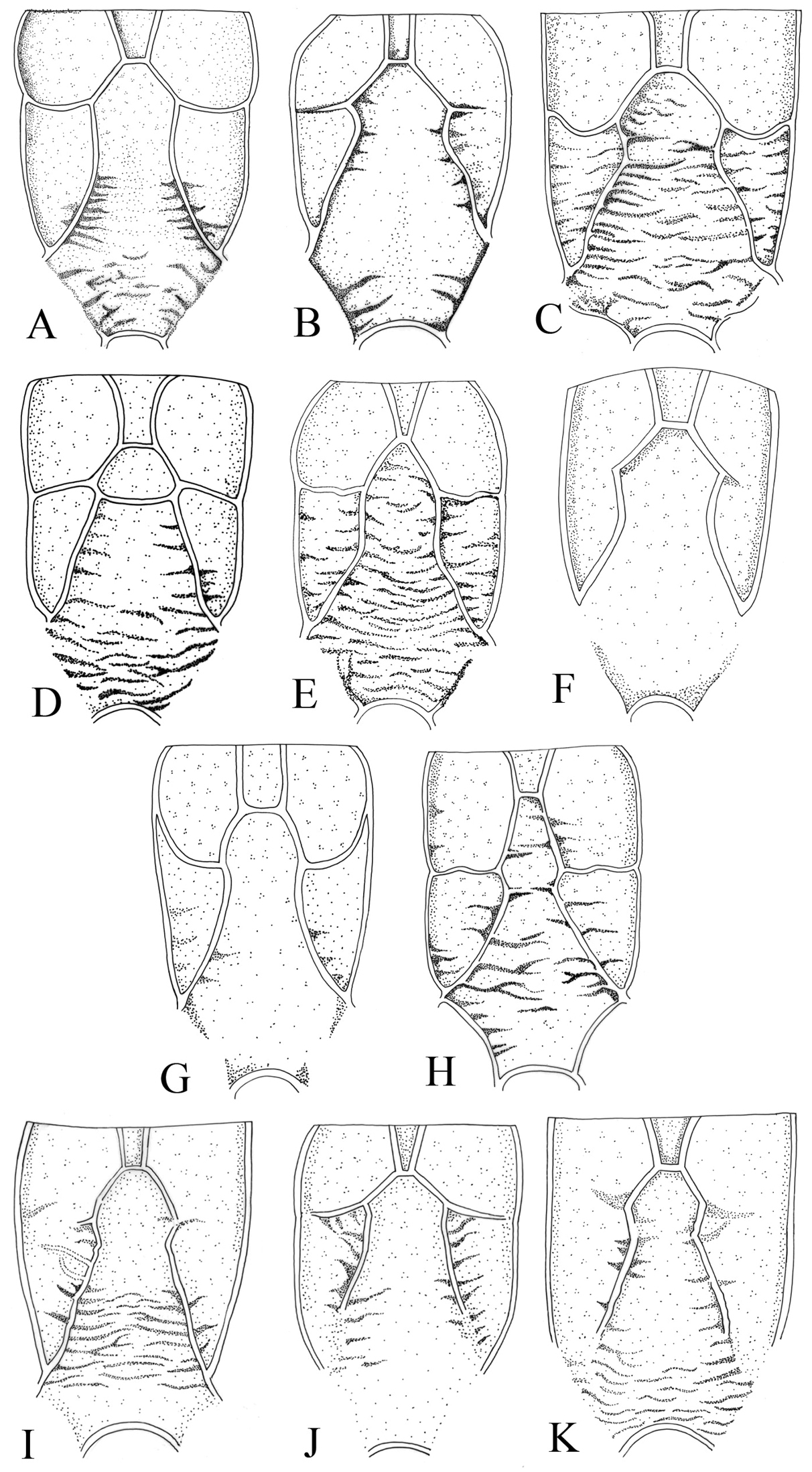






(C) 2013 Jin-Kyung Choi. This is an open access article distributed under the terms of the Creative Commons Attribution License 3.0 (CC-BY), which permits unrestricted use, distribution, and reproduction in any medium, provided the original author and source are credited.
For reference, use of the paginated PDF or printed version of this article is recommended.
Korean species of the genus Cymodusa Holmgren (Hymenoptera: Ichneumonidae: Campopleginae) are reviewed. Four species of Cymodusa (Cymodusa) are reported from Korea, including one newly recorded species, Cymodusa aenigma Dbar (1985), and three new species, Cymodusa koreana sp. n., Cymodusa yeungnamensis sp. n. and Cymodusa geolimi sp. n. This genus is reported for the first time from Korea. Descriptions with photographs of new species, line drawings of propodeum and metasomal tergites of the Palaearctic species of the “australis” group and a key to the Korean Cymodusa species are provided.
Cymodusa aenigma Dbar , Cymodusa koreana sp. n. , Cymodusa yeungnamensis sp. n. , Cymodusa geolimi sp. n. , taxonomy
The genus Cymodusa Holmgren (1859) is a moderately large genus in the subfamily Campopleginae Förster with contains about 40 described species from the Eastern Palaearctic, Nearctic, Neotropical, Oriental and Western Palaearctic regions (
The “australis” group can easily be distinguished from the other species groups by the following characteristics: temple very narrowed; areolet with the 2nd recurrent vein before the middle; 6th and 7th tergites deeply emarginate in dorsal view.
In this study, we report the “australis” group of Cymodusa for the first time from Korea, including one newly recorded species and three new species.
Materials used in this work were collected by sweeping and Malaise trapping, and were deposited in the animal systematic laboratory of the Yeungnam University (YNU, Gyeongsan, Korea). Some specimens examined in this study were loaned by the Naturhistoriska Riksmuseet, Sektionen for Entomologi (Swedish Museum of Natural History Department of Entomology) (NR, Stockholm, Sweden). Specimens were examined using a stereo microscope (Zeiss Stemi SV 11 Apo; Carl Zeiss, Göttingen, Germany) and key characters shown in the photographs were produced using a Delta imaging system (i-Delta 2.6; iMTechnology, Daejeon, Korea). The morphological terminology is mostly that of
| 1 | Costula of propodeum complete (Fig. 5A); spiracle of propodeum very small circle, its diameter shorter than carina linking spiracle to pleural carina (Fig. 1I) | Cymodusa aenigma |
| – | Costula of propodeum incomplete or absent (Fig. 5I); spiracle of propodeum large, its diameter longer than carina linking spiracle to pleural carina (Fig. 2H) | 2 |
| 2 | Mandible blackish brown (Figs 4C and D); areolet of fore wing with stalk (Fig. 4M) | Cymodusa geolimi sp. n. |
| – | Mandible yellowish brown (Figs 3C); areolet of fore wing without stalk (Fig. 3L) | 3 |
| 3 | Spiracle of propodeum large (Fig. 3I); first to third flagellomeres to yellowish brown (Fig. 3M); notaulus absent (Fig. 3F) | Cymodusa yeungnamensis sp. n. |
| – | Spiracle of propodeum small (Fig. 2H); all antennal flagellomeres blackish brown; notaulus present as weak trace (Fig. 2F) | Cymodusa koreana sp. n. |
http://species-id.net/wiki/Cymodusa
Eyes densely setose. Inner margins of eyes strongly convergent ventrally. Clypeus small; apical margin rounded; weakly convex, not separated from face. Mandible short, upper tooth as long as or longer than lower tooth. Hind basitarsus without a median ventral row of close setae. Fore wing with areolet; nervulus opposite to basal vein or distad of it. Thyridium longitudinally elliptic. Ovipositor straight, with dorsal subapical notch.
http://species-id.net/wiki/Cymodusa_aenigma
Figs 1, 5A, 6A[Korea]: 2 females, Mureung valley, Samhwa-dong, Donghae-si GW, Korea, 15 July–1 August 2005, MT (Malaise trap), J.W. Lee; 1 female, ditto, 9–17 August 2005, MT, J.W. Lee; 1 female, ditto, 31 August-10 September 2005, MT, J.W. Lee.
Female. Body length 6.1 mm.
Fore wing length 3.3–3.8 mm.
Antenna with 34–35 flagellomeres.
Color. Head black. Scape and pedicel blackish brown. Mandible yellow, apically brown; labial and maxillary palps pale yellow. Antenna blackish brown. Mesosoma black. Tegula brown. Fore leg yellow; mid leg yellowish brown; hind coxa black, trochanter dark brown, femur and tibia brown, tarsus blackish brown. Metasoma black. Thyridium reddish brown. 5th to 7th metasomal segments reddish brown. Ovipositor yellowish brown.
Head: Head finely and densely punctate. Occiput flat and polished. Temple broad and convex, finely punctate. Mandible very short, upper tooth longer than lower tooth (Fig. 1D). Ocelli slightly large; diameter of median ocellus 1.1 times as long as distance between ocellus and eye; lateral ocellus separated from eye by 0.9 times lateral ocellus diameter.
Mesosoma: Pronotum covered with transverse striae (Fig. 1E); epomia distinct. Mesoscutum finely and densely punctate; notaulus absent (Fig. 1G). Mesopleuron roughly punctate, reticulate; postpectal carina complete; epicnemial carina short; sternaulus absent; speculum convex, impunctate, polished (Fig. 1F); scutellum finely granulate. Propodeum with numerous transverse rugae and reticulate; basal area and areola separated by anterior transverse carina (Fig. 1H); areola and petiolar area not separated, impressed medially; costula complete (Fig. 5A); spiracle very small, round, connected to pleural carina; distance between spiracle and pleural carina 1.7 times as diameter of spiracle (Fig. 1I). Hind tibia with short spines; ratios between hind tarsal segments 4.5: 2.2: 1.6: 0.8: 0.9. Fore wing with areolet; basal vein opposite nervulus (Fig. 1L); nervellus not intercepted; discoidella absent.
Metasoma: Thyridium small, oval; separated from base of 2nd tergite by more than 3.0 times its diameter; distance between base of 2nd tergite and thyridium 0.6 times distance between base of 2nd tergite and spiracle (Fig. 1K). 6th and 7th tergites deeply emarginate apically (Fig. 1M). Ovipositor (Fig. 1N) shorter than metasoma, 1.4 times as long as hind tibia.
Male. Unknown.
Cymodusa (Cymodusa) aenigma Dbar, 1985 (female). A habitus in lateral view B head in lateral view C head in frontal view D mandible E pronotum F mesopleuron in lateral view G mesoscutum in dorsal view H propodeum I spiracle of propodeum J petiole in lateral view K thyridium L wings M 6th and 7th tergites in dorsal view N ovipositor. (Scale bar 1 mm for A; 0.5 mm for L; 0.2 mm for B, C, E–H, J, K, M and N; 0.1 mm for D and I).
Korea (new record), Japan, Russia (Khabarovsk, Primor’ye Kray).
urn:lsid:zoobank.org:act:AEEED4C3-D4B6-4E22-9E00-C20FB416D51E
http://species-id.net/wiki/Cymodusa_koreana
Figs 2, 5I, 6F, 7AHolotype: [Korea] (TD: YNU): 1 female, Unmunsa, Chungdo-gun, GB, Korea, 21.V.1989, I.S. Ye.
Paratypes: [Korea] (TD: YNU): 1 female, Gyeonbongsa, Ganseong, GW, Korea, 22 May 1992, J.W. Lee; 1 female, Mureung Valley, Samhwa-dong, Donghae-si, GW, Korea, 20 September–2 October 2006, MT, J.W. Lee; 1 female, ditto, 28 August-10 September 2006, MT, J.W. Lee; 1 female, Yeungnam Univ., Gyeongsan-si, GB, 13 May 1985, E.S. Kim; 1 female, Mirimsan, Bonghwa-gun, 4 May 1997, J.C. Jeong.
(female holotype). Body length 7.3 mm.
Fore wing length 4.1 mm.
Antenna with 31–32 flagellomeres.
Color. Head, scape and pedicel black. Mandible yellow, apically brown. Labial and maxillary palps pale yellow. Antenna blackish brown. Mesosoma black. Tegula yellow. Fore leg yellow; mid leg yellowish brown; hind coxa black, trochanter dark brown, trochantellus yellow, femur brown, tibia yellow medially, brown basally and apically, tarsus brown. Metasoma black, tergites apically narrowly reddish brown. Thyridium reddish brown.
Head: Head finely and densely punctate. Occiput flat and polished. Temple broad and convex, finely punctate. Mandible very short, upper tooth as long as lower tooth (Fig. 2C). Minimum distance between eyes 0.6 times as long as maximum distance (Fig. 2B). Ocelli small; diameter of median ocellus 0.9 times as long as distance between ocellus and eye; lateral ocellus separated from eye by 1.3 times of lateral ocellus diameter. Antenna with 31–32 flagellomeres, 1st flagellomere 1.3 times as long as 2nd flagellomere.
Mesosoma: Pronotum with transverse striae ventrally (Fig. 2D); epomia weak. Mesoscutum finely and densely punctate; notaulus absent (Fig. 2F). Mesopleuron roughly punctate, reticulate; postpectal carinae complete, epicnemial carina short; sternaulus absent. Scutellum finely punctate; postscutellum broader than high. Propodeum with numerous transverse rugae and reticulate; basal area and areola separated by anterior transverse carina; costula absent (Fig. 5I); areola and petiolar area not separated, impressed medially (Fig. 2G); spiracle small, round, connected to pleural carina, distance between spiracle and pleural carina 0.9 times as long as diameter of spiracle (Fig. 2H). Hind tibia with short spines; ratio between hind tarsal segments 5.0: 2.2: 1.5: 0.9: 0.9. Fore wing with areolet; basal vein opposite nervulus; nervellus not intercepted; discoidella absent (Fig. 2L).
Metasoma: Thyridium small, oval; separated from base of 2nd tergite by more than 2.0 times its diameter; distance between base of 2nd tergite and thyridium 0.5 times as long as distance between base of 2nd tergite and spiracle (Fig. 2K). 6th and 7th tergites deeply emarginate apically (Fig. 2M). Ovipositor 1.5 times as long as hind tibia (Fig. 2J).
Male. Unknown.
Cymodusa (Cymodusa) koreana Choi & Lee sp. n. (female). A habitus in lateral view B head in frontal view C mandible D pronotum E mesopleuron in lateral view F mesoscutum in dorsal view G propodeum H spiracle of propodeum I petiole in lateral view J ovipositor K thyridium L wings M 6th and 7th tergites in dorsal view. (Scale bar 1 mm for A; 0.5 mm for L; 0.2 mm for B, E–G, I–K and M; 0.1 mm for C, D and H).
Korea.
The specific name is derived from Korea, the locality of the type specimens.
This species is similar to Cymodusa rufiventris Dbar, 1985 in the structure of the propodeum and costula, but the basal area is different, areolet is sessile and pentagonal, and the metasoma is darker.
urn:lsid:zoobank.org:act:2BF6F784-E72A-411C-BB6D-44DDD147738B
http://species-id.net/wiki/Cymodusa_yeungnamensis
Figs 3, 5J, 6G, 7BHolotype: [Korea] (TD: YNU): 1 female, Yeungnam Univ., Gyeungsan-si, GB, Korea, 21 May 1990, M.J. Kim.
Paratype: [Korea] (TD: YNU): 1 female, Yeungnam Univ., Gyeungsan-si, GB, Korea, 19 June 1992, G.Y. Lee.
(female holotype). Body length 6.9 mm.
Fore wing length 4.0 mm.
Antenna with 18+ flagellomeres, apical flagellomeres missing. (antenna with 32 flagellomeres at paratype)
Color. Head black. Scape and pedicel blackish brown. Antenna black, except 3 antennal flagellomeres yellow. Mandible yellow, brown apically. Mesosoma black; tegula brown. Fore leg yellowish brown; mid coxa black, brown apically, trochanter and trochantellus yellow, femur to tarsus brown; hind coxa and trochanter black, trochantellus yellow, femur blackish brown, tibia reddish brown, blackish brown basally and apically, tarsus blackish brown. Metasoma blackish brown; petiole black. Thyridium reddish brown. Ovipositor brown.
Head: Head densely finely punctate; Vertex slightly punctate. Occiput flat and polished. Temple finely punctate and flat. Mandible very short, upper tooth as long as lower one (Fig. 3C). Minimum distance between eyes 0.6 times as long as maximum distance (Fig. 3B). Ocelli small; diameter of median ocellus 0.8 times as long as distance between ocellus and eye; lateral ocellus separated from eye by 1.6 times of lateral ocellus diameter. Antenna with 32 flagellomeres, 1st flagellomere 1.5 times as long as 2nd flagellomere.
Mesosoma: Pronotum sparsely punctate; upper part reticulate; ventrally with transverse striae (Fig. 3D); epomia absent. Mesoscutum closely and finely punctate; notaulus absent (Fig. 3F). Mesopleuron reticulate; postpectal carinae complete; epicnemial carina reaching anterior margin of mesopleuron at its middle (Fig. 3E); epicnemial carina present; sternaulus absent. Scutellum closely punctate; postscutellum flat, broader than high. Propodeum reticulated; basal area and areola not separated by anterior transverse carina; costula present but incomplete (Fig. 5J); areola and petiolar area not separated, impressed (Fig. 3H); spiracle round; connected to pleural carina; distance between spiracle and pleural carina 0.7 times as long as diameter of spiracle (Fig. 3I). Hind tibia with short spines; ratio between hind tarsal segments 5.1: 2.4: 1.6: 0.9: 1.0. Fore wing with areolet (Fig. 3L); basal vein opposite nervulus; nervellus not intercepted; discoidella absent.
Metasoma: Thyridium separated from base of 2nd tergite by more than 3.0 times its diameter; distance between base of 2nd tergite and thyridium 0.5 times as long as distance between base of 2nd tergite and spiracle (Fig. 3K). 6th and 7th tergites deeply emarginate apically (Fig. 3N). Ovipositor (Fig. 3G) 1.6 times as long as hind tibia.
Male. Unknown.
Cymodusa (Cymodusa) yeungnamensis Choi & Lee sp. n. (female). A habitus in lateral view B head in frontal view C mandible D pronotum E mesopleuron in lateral view F mesoscutum in dorsal view G ovipositor H propodeum I spiracle of propodeum J petiole in lateral view K thyridium L wings M antenna N 6th and 7th tergites in dorsal. (Scale bar 1 mm for A; 0.5 mm for L; 0.2 mm for B–H, J, K, M and N; 0.1 mm for I).
Korea.
The specific name is derived from the locality of the type specimens.
This species is similar to Cymodusa aenigma Dbar, 1985, but the areolet is not sessile and the basal 1st to 3rd flagellomeres are yellow below (as in Cymodusa leucocera Holmgren and Cymodusa distincta Cresson).
urn:lsid:zoobank.org:act:78152C58-FD90-4622-B380-53174A5C55BC
http://species-id.net/wiki/Cymodusa_geolimi
Figs 4, 5K, 6H, 7CHolotype: [Korea] (TD: YNU): 1 female, Mureung valley, Samhwa-dong, Donghae-si GW, Korea, 16-28 June 2005, MT, J.W. Lee.
Paratype: [Korea] (TD: YNU): 1 female, Gajoa-dong, Jinju-si, GN, Korea, 3-9 June 1989, J.W. Lee.
(female holotype). Body length 5.8 mm.
Fore wing length 3.4 mm.
Antenna with 31 flagellomeres.
Color. Head black. Scape and pedicel blackish brown. Antenna black. Mandible yellow, brown apically. Mesosoma black; tegula brown. Fore leg yellowish brown; mid coxa black, brown apically, trochanter and trochantellus yellow, femur to tarsus brown; hind coxa and trochanter black, trochantellus yellow, femur blackish brown, tibia reddish brown, blackish brown basally and apically, tarsus blackish brown. Metasoma blackish brown; petiole black. Thyridium reddish brown. Ovipositor brown.
Head: Head closely and finely punctate. Vertex slightly punctate. Occiput flat and polished. Temple finely punctate and flat. Mandibles short, upper tooth as long as lower one. Minimum distance between eyes 0.6 times as long as maximum distance (Fig. 4C). Ocelli small; diameter of median ocellus 0.9 times as long as distance between ocellus and eye; lateral ocellus separated from eye by 1.0 times lateral ocellus diameter. Antenna with 31 flagellomeres, 1st flagellomere 1.3 times as long as 2nd flagellomere.
Mesosoma: Pronotum sparsely punctate; upper part reticulated; lower part with transverse striae; epomia absent. Mesoscutum closely and finely punctate; notaulus absent (Fig. 4G). Mesopleuron reticulate (Fig. 4F); postpectal carinae complete; epicnemial carina present; sternaulus absent. Scutellum closely punctate; postscutellum flat, broader than high. Propodeum reticulate; basal area and areola separated by anterior transverse carina (Fig. 5K); costula weak; areola and petiolar area not separated, impressed; spiracle small, round; distance between spiracle and pleural carina 1.00 times diameter of spiracle (Fig. 4I). Hind tibia with short spines; ratio between hind tarsal segments 4.4: 2.0: 1.3: 0.7: 0.9. Fore wing with areolet; basal vein opposite nervulus (Fig. 4M); nervellus not intercepted; discoidella absent.
Metasoma: Thyridium separated from base of 2nd tergite by more than 4.0 times its diameter; distance between base of 2nd tergite and thyridium 0.6 times as long as distance between base of 2nd tergite and spiracle (Fig. 4L). 6th and 7th terga deeply emarginate apically (Fig. 4N); 7th tergite longer than 6th tergite (Fig. 6H). Ovipositor (Fig. 4K) shorter than metasoma, 1.7 times as long as hind tibia.
Male. Unknown.
Cymodusa (Cymodusa) geolimi Choi & Lee sp. n. (female). A habitus in lateral view B head in lateral view C head in frontal view D mandible E pronotum F mesopleuron in lateral view G mesoscutum in dorsal view H propodeum I spiracle of propodeum J petiole in lateral view K ovipositor L thyridium M wings N 6th and 7th tergites in dorsal view. (Scale bar 1 mm for A; 0.5 mm for M; 0.2 mm for B–L and N).
Propodeum, dorsal, of “australis” group. A Cymodusa aenigma B Cymodusa australis C Cymodusa longiterebra D Cymodusa oculator E Cymodusa orientalis F Cymodusa parva G Cymodusa rufiventris H Cymodusa tibialis I Cymodusa koreana sp. n. J Cymodusa yeungnamensis sp. n. K Cymodusa geolimi sp. n.
6th and 7th metasomal terga, dorsal, of “australis” group. A Cymodusa aenigma B Cymodusa longiterebra C Cymodusa orientalis D Cymodusa rufiventris E Cymodusa tibialis F Cymodusa koreana sp. n. G Cymodusa yeungnamensis sp. n. H Cymodusa geolimi sp. n.
Korea.
The species is named after the nickname of Dr. Jong-Wook Lee, who collected the type specimens.
This species is similar to Cymodusa oculator Dbar (1985) but differs by the number of flagellar segments, developed clypeal fovea, basal area and areola not separated, and a different color pattern.
We are deeply grateful to Dr. Gavin Broad and anonymous reviewer for reviewing this manuscript, and thank Dr. Hege Vårdal of the Swedish Museum of Natural History Stockholm, Sweden, for providing type and voucher specimens used in this study. This work was supported by the 2013 Yeungnam University Research Grant and a grant from the National Institute of Biological Resources (NIBR), funded by the Ministry of Environment (MOE) of the Republic of Korea (NIBR No. 2013-02-001).
